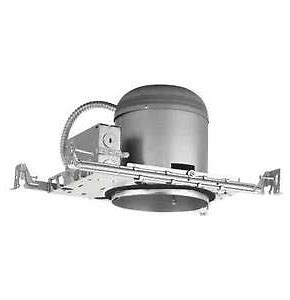Lighting in homes can generate a lot of heat and can potentially cause a fire hazard. NJ Home Inspectors should look for and identify if high hat lights in the home that they are inspecting are IC-rated or standard high-hat lights.
IC rated high hat lights are high hat cans that are approved to have insulation installed touching them. The IC means rated for insulation contact. It is important for New Jersey home inspectors to identify non-IC rated high hat light fixtures that have insulation installed too close to them because this is a significant fire hazard. The mechanism of the fire hazard is that the light bulbs are located in an enclosed space within the can. As the light overheats the single can overheat the paper on the insulation causing a fire. The second mechanism of a fire is that the bulb heats the electrical wiring until it melts causing a fire hazard.
Home inspectors should be able to identify the difference by looking at the construction of the high-hat light can. This can be done while inspecting the attic space. IC rated high hat lights are made with a double hull design or a can in can design. The outer protective cover or can will allow the high hat to have insulation installed touching it. An air gap exists in between the two covers of the IC light allowing for the protection against overheating. Both blown in insulation or batt style insulation can be used touching these IC type can light.
On the other hand non IC rated high hat lights are constructed with only a single can around them. These lights are a good option when insulation is not needed. The open air around the light fixture allows the heat to dissipate thus reducing the fire hazard. These lights typically have open vents around the light can and when on light can be seen through these vent holes. Home inspectors in New Jersey should be able to identify the difference. Also, non-IC lights are usually white in color where IC lights have a silver outer can. If you encounter these non-IC rated high hat lights in an attic insulation should be removed to at least four inches around the light can in order to avoid fire hazards.
As a home inspector I encounter non-IC rated high hat lights with insulation touching them or installed over them often. When we discover these lights, we should recommend to our clients that the high-hat lights be upgraded to IC type lights in order to avoid fire hazards.
What are other things that home inspectors and homeowners can look for to help identify what type of high-hat lights they have. From the attic a home inspector or a homeowner can look for the label. Sometimes the label is inside the can light and the bulb has to be removed to see it. Some lights have a label that can be seen on the back of the can. Typically, a non-IC rated high hat will be labeled non-IC compliant. Most IC-rated lights will have the letters “IC” in the model number and non-IC type lights will have “NON-IC” on the label including the maximum wattage that the light fixture will accommodate safely.
There is also a problem with just removing the insulation from around a non-IC type high hat light. If there is a gap between the high hat can and the uninsulated moist hot air from the home will find its way into these non-insulated gaps into the attic space. This will add significantly to energy bills in the winter months. Another major issue is there is the potential for ice dam formation. Hot escaping air from the home into the attic will melt snow on the roof at a fast rate and create conditions that are conducive for ice dam formation. Frost can also build up in the attic pace caused by gaps around non-IC type can lights.
Some people have asked the question is it ok to replace the bulbs in older incandescent non-IC type high hat with LED (light emitting diode) bulbs. The drivers for the LED”S throw off a lot of heat and if you have insulation around them that is still a fire hazard. Also, what if you sell the home and the new occupants replace the LEDs with standard bulbs?
NJ home inspectors should be familiar with both IC and non-IC type high hat lights. When non-IC high hats exist, we should educate our clients on the possible fire hazards and recommend replacement to IC-type high hat lights.

